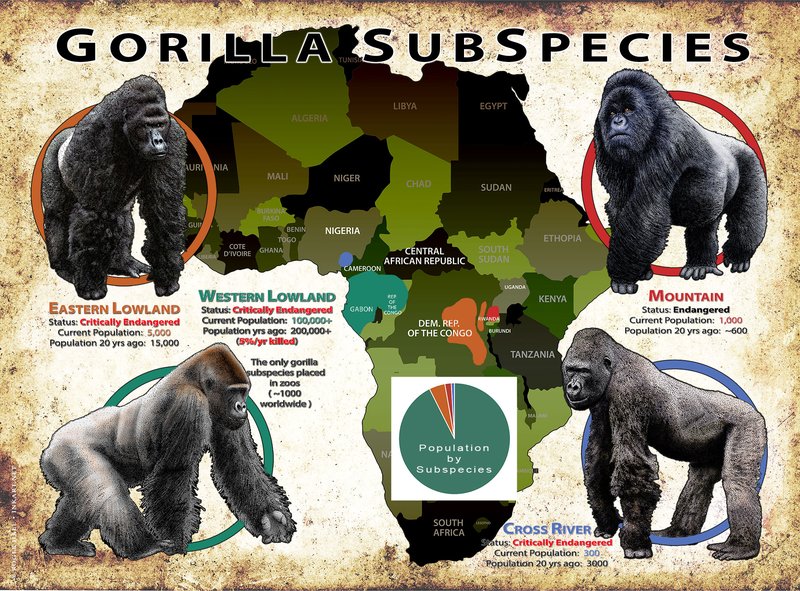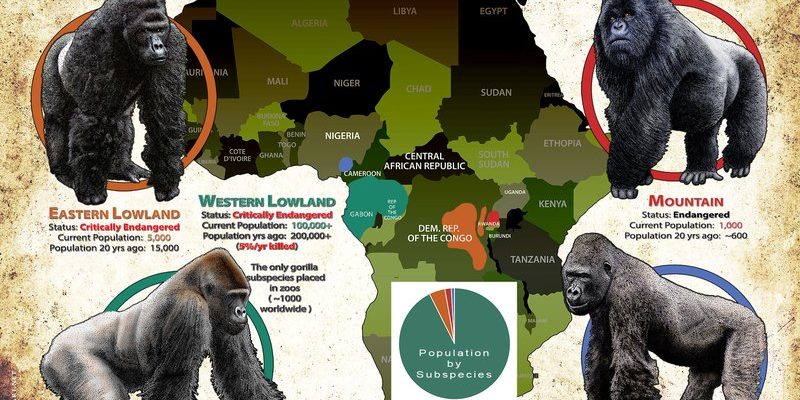
Western gorillas are one of two species of gorillas, and they’re primarily found in the dense rainforests of West and Central Africa. Picture a lush, green landscape filled with towering trees, thick vines, and the sounds of various wildlife. It’s quite different from the typical image we often see in movies. The reality of their habitat is both beautiful and vital for their survival. Understanding where they live helps us appreciate their needs and the challenges they face in the wild.
Understanding the Western Gorilla
Before delving into their habitat, let’s get to know the western gorilla a little better. This species is divided into two main subspecies: the western lowland gorilla and the Cross River gorilla. While both are part of the same family, they live in slightly different areas and have unique traits.
Western lowland gorillas are the most numerous, often found in the swampy forests and lowland tropical rainforests. On the other hand, the Cross River gorilla is critically endangered, with only a few hundred individuals left, primarily living around the border between Nigeria and Cameroon. This division is crucial because it shows how varied their environment can be, even within the same species.
These gorillas usually live in groups called troops, which consist of several females and their young, led by a dominant male known as a silverback. The troop structure is essential for their social lives and helps them survive in the wild.
Typical Habitat of Western Gorillas
The typical habitat of **western gorillas** includes various ecosystems, but they primarily thrive in tropical rainforests, swamps, and lowland woodlands. Imagine a world where sunlight filters through thick canopies, creating a mosaic of light and shadow on the forest floor. This environment is rich in biodiversity, providing ample food sources like fruits, leaves, and flowers.
Rainforests are particularly important because they offer shelter and protection from potential predators. The dense foliage serves as a fortress, allowing gorillas to live in relative safety. Their diet is mainly herbivorous, meaning they munch on a wide array of plants, making the lushness of their habitat vital for their sustenance.
Western gorillas are also known to adapt to different areas, which is why some live in swampy regions. Here, they can find unique plants and access water sources, showcasing their ability to thrive in various environments.
Distribution of Western Gorillas
Now, let’s talk about where in the world you can find these incredible creatures. Western gorillas are mainly distributed across several countries in Africa, including Cameroon, Gabon, the Republic of the Congo, the Democratic Republic of the Congo, and parts of Angola.
Imagine spreading a map across the table and marking these locations. You’d find large sections of dense forest that create a patchwork of habitats. The western lowland gorilla is the most widespread of the two subspecies, with populations found in many of these countries. In contrast, the Cross River gorilla is more localized, only inhabiting a specific mountainous area along the border of Nigeria and Cameroon.
This limited range makes the Cross River gorilla particularly vulnerable to threats, such as habitat loss and poaching, emphasizing the importance of conservation efforts in these areas.
Factors Affecting Habitat
Many factors influence the habitat of western gorillas. One of the biggest threats they face is **deforestation**, primarily driven by logging, agriculture, and human settlement. Imagine a once-vibrant forest slowly being replaced by farmland or cities. This not only reduces the area where gorillas can live but also fragments their populations, making it harder for them to find mates and maintain healthy genetic diversity.
Climate change also poses a challenge. Changes in weather patterns can affect the availability of food and water in their habitats. If the plants gorillas rely on start to disappear due to extreme weather, it can greatly impact their survival.
Moreover, human activities, such as hunting, pose a significant danger to these animals. The illegal wildlife trade has led to a decline in their populations. Understanding these threats is crucial for raising awareness and prompting actions that can help protect their habitats.
The Importance of Conservation
Conservation efforts are key to protecting the habitats of western gorillas. Many organizations are working tirelessly to create protected areas and establish wildlife corridors that allow gorillas to roam and breed more freely. These efforts are like building bridges in a fragmented landscape, ensuring that gorillas can thrive despite the challenges posed by their environment.
Additionally, educating local communities about the importance of gorillas and their ecosystems plays a significant role. When people understand the value of preserving these habitats, they’re more likely to participate in conservation efforts. It’s a bit like planting seeds of knowledge that can grow into a thriving community commitment to protect their environment.
Moreover, eco-tourism initiatives allow people to visit these beautiful habitats in a way that supports local economies while promoting gorilla conservation. This not only raises awareness but also provides financial resources to protect these majestic animals and their homes.
Future of Western Gorillas
Looking ahead, the future of **western gorillas** largely depends on continued conservation efforts and global awareness. It’s essential that we work together to protect their habitats and ensure these wonderful animals can flourish in the wild.
Every small action counts. Whether it’s supporting sustainable products, promoting awareness through social media, or participating in conservation programs, every effort contributes to preserving their ecosystem.
Ultimately, the story of western gorillas is a reminder of the intricate web of life in our world and how interconnected we all are. Their fight for survival is a battle that we can all be a part of, cherishing and protecting the beautiful habitats that support them.
In conclusion, western gorillas inhabit a unique and diverse range of environments in West and Central Africa, from lush tropical forests to swampy areas. Understanding where they live helps us appreciate their role in the ecosystem and the challenges they face. By supporting conservation efforts, we can help ensure that these stunning creatures have a future in the wild where they belong.

